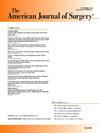利用远程医疗优化腹疝修补术后的长期监测
IF 2.7
3区 医学
Q1 SURGERY
引用次数: 0
摘要
腹疝仍然是一个具有长期并发症和复发的具有挑战性的手术条件。本研究评估了标准化的基于远程医疗的随访是否改善了腹侧疝修补术后的长期监测。方法:一项回顾性队列研究比较了在三级疝中心进行腹侧疝修补的患者的基于远程医疗的监测与传统的面对面随访。6个月、12个月和24个月的随访依从性是主要关注的结果。结果基于远程医学的监测显著提高了随访依从性;6个月时79% vs. 44%, 12个月时69% vs. 42%, 24个月时44% vs. 14%。复发率没有显著差异,但远程医疗有助于早期识别患者的担忧(24%),从而选择额外的干预措施,如横断面成像或补充的面对面评估(10%)。结论远程医疗提高了腹疝修补术后的随访依从性和早期发现并发症。它为长期患者护理提供了一种负担得起的解决方案,尽管需要进一步的研究来优化方案本文章由计算机程序翻译,如有差异,请以英文原文为准。
Utilizing Telehealth to optimize long term surveillance following ventral hernia repair
Introduction
Ventral hernias remain a challenging surgical condition with long-term complications and recurrences. This study evaluates whether standardized telemedicine-based follow-up improves long-term surveillance following ventral hernia repaiI
Methods
A retrospective cohort study compared telemedicine-based surveillance with traditional in-person follow-up for patients undergoing ventral hernia repair at a tertiary hernia center. Follow-up adherence at 6-, 12-, and 24-months were the primary outcomes of interest.
Results
Telemedicine-based surveillance significantly improved follow-up adherence; 79 % vs. 44 % at 6 months, 69 % vs 42 % at 12 months, and 44 % vs 14 % at 24 months. There was no significant difference in recurrence rates, but telemedicine helped identify patient concerns (24 %) early, leading to select additional interventions such as cross-sectional imaging or supplemental in-person evaluation (10 %
Conclusions
Telemedicine improves follow-up adherence and early detection of complications after ventral hernia repair. It offers an affordable solution for long-term patient care, though further research is needed to optimize protocols
求助全文
通过发布文献求助,成功后即可免费获取论文全文。
去求助
来源期刊
CiteScore
5.00
自引率
6.70%
发文量
570
审稿时长
56 days
期刊介绍:
The American Journal of Surgery® is a peer-reviewed journal designed for the general surgeon who performs abdominal, cancer, vascular, head and neck, breast, colorectal, and other forms of surgery. AJS is the official journal of 7 major surgical societies* and publishes their official papers as well as independently submitted clinical studies, editorials, reviews, brief reports, correspondence and book reviews.

 求助内容:
求助内容: 应助结果提醒方式:
应助结果提醒方式:


